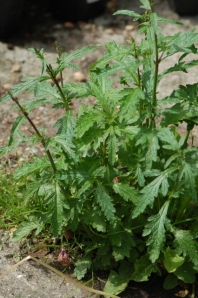Despite the incessant rain, I have been lucky enough to get good harvests of two of my very favourite plants recently; vervain from my garden and avena, or milky oat seed, from a local organic farm along with my friend Therri (known to some as the herbal muse!). Friends that I studied with used to tease me for giving these two herbs to nearly everyone that came into our clinic but they are so useful, healing and restorative that there seemed few cases where they were not indicated! Now that the vervain is about ready for pressing I thought I would share with you a few of the many reasons why I so love this wonderful plant ally. 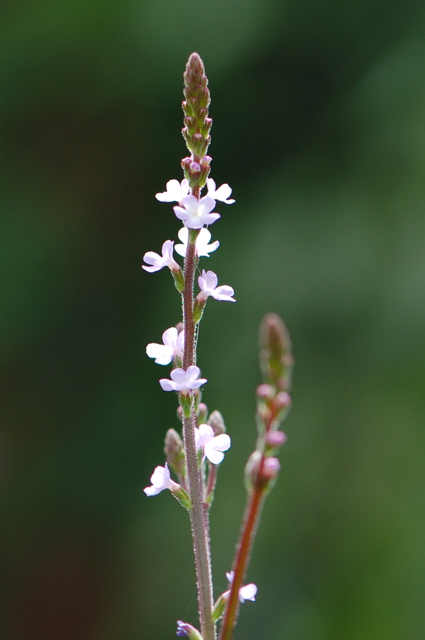 Common Name : Vervain. Also Wizard’s Herb, Herb of Enchantment, Simpler’s Joy, Holy Herb.
Common Name : Vervain. Also Wizard’s Herb, Herb of Enchantment, Simpler’s Joy, Holy Herb.
Latin: Verbena officinalis
Family: Verbenaceae
Botanical Features: A perennial herb native to Europe and parts of Asia. It has toothed, opposite leaves on spindly, branched square stems with spikes of tiny fairy-like flowers, whitish- mauve in colour.
Key constituents: Iridoides including verbenin and verbenalin, flavonoids, volatile oils, phenylpropanoids, triterpenes, mucilage, tannins and saponins.
Actions: Nervine, anti-spasmodic, sedative, diaphoretic, hepatic, alterative, galactogogue, aphrodisiac, emmenagogue, thymoleptic, vulnerary, hypotensive, anti-bacterial.
Energetics: Cooling and drying. This is a different but related species to the American native, Verbena hastata, or blue vervain, which is used in a comparable way. I have never worked with, or even tasted, this variety so I can’t make any comparison myself. It is also important to distinguish it from lemon verbena which is confusingly sometimes also called vervain. Whilst both plants belong to the wider Verbenaceae family, lemon verbena, Aloysia citrodora, (formerly Lippia ctrodora) is of a different genus. 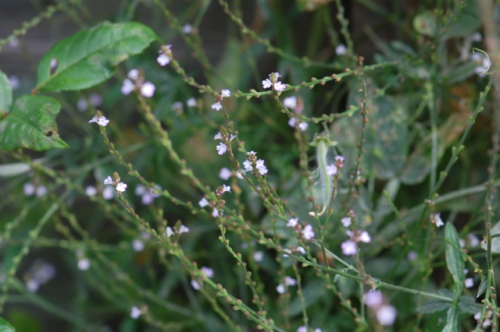 Though often described with words like, ‘straggly’, ‘meagre’ or ‘weedy’, for those who appreciate the small and the subtle, vervain is one of the most beautiful plants in the garden. It used to grow freely in the wild but is not so common these days. In fact I think I have seen it growing abundantly in the wild only twice, usually I just see a few plants here and there, so it is a plant best cultivated if you wish to ensure a harvest. The ethereal grace of vervain is hard to capture in words or images but when you sit with this plant it appears as if illuminated by the softest of radiances. To me it seems the very embodiment of the fey here in this physical world. Along with Meadowsweet, which I wrote about last week, Vervain was another of the Druid’s most sacred plants and it is often referred to as the ‘Druid’s herb’ or ‘wizard’s herb’. Interestingly it was also revered by the Egyptians, Greeks and Romans and was used as an altar herb in all these cultures. In folklore vervain was the plant used to staunch the bleeding from Christ’s wounds after he was bought down from the cross. As is so common with herbs that were popular in pre-Christian Europe they are associated both with witches, enchantment and devilment (due to their popularity in pagan times) and with holiness and therefore protection from those same forces (due to the usurping of powerful symbols by the new ideology.) From the sunny Mediterranean to the damp shores of the UK, vervain was once considered something of a cure all and was a favourite of Hippocrates himself. Tales of vervain as a universal panacea became somewhat overblown as it was considered to do such diverse things as grant love, heal any wound, treat the plague and even bestow immortality. Gerard scorns this over enthusiasm in his herbal of 1597 saying, “instead of a good and sure remedy they minister no remedy at all; for it is reported that the Divell did reveal it as a secret and divine medicine.” The truth, as is so often the case, lies somewhere in the shifting sands between. Of course it cannot bestow immortality but it does have the ability to assist in an impressive range of health conditions.
Though often described with words like, ‘straggly’, ‘meagre’ or ‘weedy’, for those who appreciate the small and the subtle, vervain is one of the most beautiful plants in the garden. It used to grow freely in the wild but is not so common these days. In fact I think I have seen it growing abundantly in the wild only twice, usually I just see a few plants here and there, so it is a plant best cultivated if you wish to ensure a harvest. The ethereal grace of vervain is hard to capture in words or images but when you sit with this plant it appears as if illuminated by the softest of radiances. To me it seems the very embodiment of the fey here in this physical world. Along with Meadowsweet, which I wrote about last week, Vervain was another of the Druid’s most sacred plants and it is often referred to as the ‘Druid’s herb’ or ‘wizard’s herb’. Interestingly it was also revered by the Egyptians, Greeks and Romans and was used as an altar herb in all these cultures. In folklore vervain was the plant used to staunch the bleeding from Christ’s wounds after he was bought down from the cross. As is so common with herbs that were popular in pre-Christian Europe they are associated both with witches, enchantment and devilment (due to their popularity in pagan times) and with holiness and therefore protection from those same forces (due to the usurping of powerful symbols by the new ideology.) From the sunny Mediterranean to the damp shores of the UK, vervain was once considered something of a cure all and was a favourite of Hippocrates himself. Tales of vervain as a universal panacea became somewhat overblown as it was considered to do such diverse things as grant love, heal any wound, treat the plague and even bestow immortality. Gerard scorns this over enthusiasm in his herbal of 1597 saying, “instead of a good and sure remedy they minister no remedy at all; for it is reported that the Divell did reveal it as a secret and divine medicine.” The truth, as is so often the case, lies somewhere in the shifting sands between. Of course it cannot bestow immortality but it does have the ability to assist in an impressive range of health conditions. 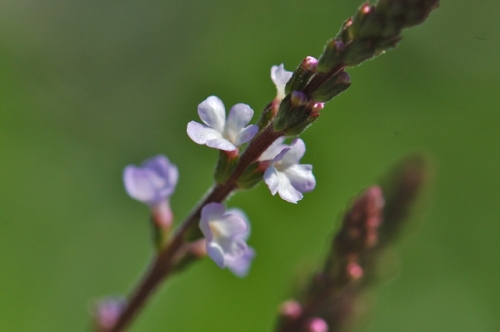 These days vervain is used primarily as a relaxing nervine with a particular affinity for the digestion and the liver/ gallbladder and this is certainly the main way that I use it. Culpepper describes it as being useful for people who are ‘frantic’ a particularly apt description I think as it calms and centers the stressed out, workaholics of this world. However it is also a fine nervous system restorative so it’s ideal for those that have been frantic and are now exhausted as a consequence or for those who are deficient due to prolonged stresses and strains. It is wonderful for sensitive souls who feel easily overwhelmed and tend to nervousness and restlessness which often manifest as constriction, cramps and poor digestion. It is a helpful herb in convalescence for this very reason and Bartram recommends it in cases of ME and post viral fatigue. It has a very calming effect so it is helpful when we feel scattered and fearful or anxious. Due to it’s affinity with the liver it is also helpful when we are irritable or angry, making it a prime tonic herb for PMS. It’s antispasmodic and calming actions help to soothe menstrual cramps and its cleansing effect on the liver helps to flush out hormones whilst increased bile flow from the gallbladder aids in bowel function and elimination. It is often used in cases of hormonal headaches due to these same effects. It helps to open and move congestion which is often an underlying factor in menstrual complaints. As vervain is slightly stimulating to the reproductive system it is best avoided in pregnancy. It has however been used to assist with labour.
These days vervain is used primarily as a relaxing nervine with a particular affinity for the digestion and the liver/ gallbladder and this is certainly the main way that I use it. Culpepper describes it as being useful for people who are ‘frantic’ a particularly apt description I think as it calms and centers the stressed out, workaholics of this world. However it is also a fine nervous system restorative so it’s ideal for those that have been frantic and are now exhausted as a consequence or for those who are deficient due to prolonged stresses and strains. It is wonderful for sensitive souls who feel easily overwhelmed and tend to nervousness and restlessness which often manifest as constriction, cramps and poor digestion. It is a helpful herb in convalescence for this very reason and Bartram recommends it in cases of ME and post viral fatigue. It has a very calming effect so it is helpful when we feel scattered and fearful or anxious. Due to it’s affinity with the liver it is also helpful when we are irritable or angry, making it a prime tonic herb for PMS. It’s antispasmodic and calming actions help to soothe menstrual cramps and its cleansing effect on the liver helps to flush out hormones whilst increased bile flow from the gallbladder aids in bowel function and elimination. It is often used in cases of hormonal headaches due to these same effects. It helps to open and move congestion which is often an underlying factor in menstrual complaints. As vervain is slightly stimulating to the reproductive system it is best avoided in pregnancy. It has however been used to assist with labour.
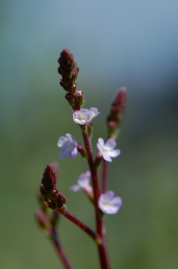
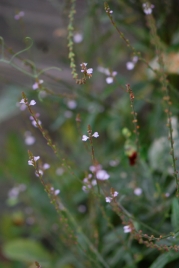 _________________________________________________________________________________________ It is a helpful ally throughout the menopause as well and helps to reduce hot flushes, dispel headaches and irritability and improve sleep. It has a hypotensive effect and can assist with palpitations. It should be teamed with more moistening herbs if dryness is a factor however. One of the reasons it helps with hot flushes is because it is a gentle diaphoretic when taken as a hot tea. This means it helps to open the periphery and release excess heat. For this reason it was often used in cold and flu blends. I don’t really use it in this way as there are other diaphoretic herbs that taste more pleasant in tea form such as elderflower, lime blossom and peppermint, but if I was in a pinch then I would certainly turn to vervain. Like many diaphoretics, when taken as a cold tea the action is more diuretic so it can be useful for promoting kidney function and has even been used for kidney stones in the past, probably due to it’s mix of anti-spasmodic, pain relieving, diuretic and tonifying actions.
_________________________________________________________________________________________ It is a helpful ally throughout the menopause as well and helps to reduce hot flushes, dispel headaches and irritability and improve sleep. It has a hypotensive effect and can assist with palpitations. It should be teamed with more moistening herbs if dryness is a factor however. One of the reasons it helps with hot flushes is because it is a gentle diaphoretic when taken as a hot tea. This means it helps to open the periphery and release excess heat. For this reason it was often used in cold and flu blends. I don’t really use it in this way as there are other diaphoretic herbs that taste more pleasant in tea form such as elderflower, lime blossom and peppermint, but if I was in a pinch then I would certainly turn to vervain. Like many diaphoretics, when taken as a cold tea the action is more diuretic so it can be useful for promoting kidney function and has even been used for kidney stones in the past, probably due to it’s mix of anti-spasmodic, pain relieving, diuretic and tonifying actions. 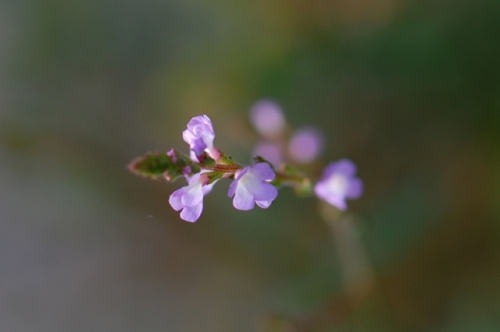 Vervain is certainly a key herb for promoting digestive function as it increases digestive juices, improves absorption and assimilation and promotes bile flow and emulsification of fats. It helps to stimulate the appetite and also relaxes the stomach when tension is held there, both of which are key for promoting digestion. When we are stressed out, our digestion shuts down as it is seen as non essential when we are dealing with a serious threat and the ability to breath deeply, run away or fight is prioritised. Chronic stress results in chronic digestive tension meaning that the digestive juices don’t flow well, we feel less hungry and our energy is sourced from our adrenal glands. This in turn places stress on the liver and we can become prone to cramps and spasms as the nervous system goes into overdrive. It combines very nicely with chamomile and gentle digestive spices where this is the case and is an important herb to consider in cases of IBS because of it’s affinity with both the nerves and the digestion. It’s gentle astringency made it popular as a wound herb in the past and also as a mouthwash for sore, bleeding or inflamed gums. This ability to tone mucus membranes along with the antispasmodic action means it was once used to treat coughs and asthma. Juliette de Baïracli Levy recommends it, ‘for pulmonary ailments, including asthma, pneumonia, tuberculosis, whooping cough.”
Vervain is certainly a key herb for promoting digestive function as it increases digestive juices, improves absorption and assimilation and promotes bile flow and emulsification of fats. It helps to stimulate the appetite and also relaxes the stomach when tension is held there, both of which are key for promoting digestion. When we are stressed out, our digestion shuts down as it is seen as non essential when we are dealing with a serious threat and the ability to breath deeply, run away or fight is prioritised. Chronic stress results in chronic digestive tension meaning that the digestive juices don’t flow well, we feel less hungry and our energy is sourced from our adrenal glands. This in turn places stress on the liver and we can become prone to cramps and spasms as the nervous system goes into overdrive. It combines very nicely with chamomile and gentle digestive spices where this is the case and is an important herb to consider in cases of IBS because of it’s affinity with both the nerves and the digestion. It’s gentle astringency made it popular as a wound herb in the past and also as a mouthwash for sore, bleeding or inflamed gums. This ability to tone mucus membranes along with the antispasmodic action means it was once used to treat coughs and asthma. Juliette de Baïracli Levy recommends it, ‘for pulmonary ailments, including asthma, pneumonia, tuberculosis, whooping cough.”
Vervain is bitter-bitter, of this there is no denying, but it also has a kind of softness that other bitters often lack, making it both grounding and uplifting all at once. It is considered a thymoleptic, that is a substance that favourably modifies the mood and is therefore useful in cases of mild depression, especially when it’s accompanied by anxiety. Like many diaphoretic herbs it has a gently opening quality which makes you feel more present and connected, less closed in and contracted. It is a very balancing herb and it is perhaps because of this that I find it to be suitable for most people’s constitutions. Though some might disagree, due to it’s cooling and somewhat drying nature, it seems beneficial to almost everyone, especially when used with other herbs that are specific to an individual’s constitution. When working with someone with nervous and digestive complaints – which so often go hand in hand – it would always be high on my list of considerations. For the Vata person who can tend to be anxious and ungrounded it is ideal as a nerve restorative and anti-spasmodic. For them I like to team it with something deeply nourishing like avena and a gently warming digestive spice like cardamom. For the Kapha person who can be heavy, damp and sluggish it is great to clear obstructions, and promote the flow of bile from the gallbladder. I would want to add something more heating and drying such as dry ginger and rosemary for this individual. For the Pitta person it’s qualities are ideal to drain excess heat, calm stress and hypertension and release irritability. For these folk it is nice with skullcap and melissa or peppermint. For the most part I use vervain in tincture form as it is a bit bitter to make a pleasant tea. You can also make capsules from the dried and finely ground herb if you prefer however. 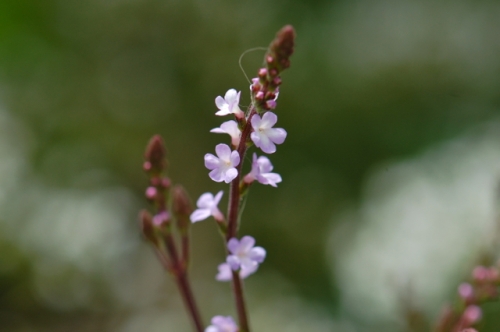 There is no doubt that this is one of the most useful and precious herbs in my dispensary as well as one of the most beautiful in my gaden. When I read of how people in India venerate the sacred herb Tulsi, also known as the ‘Incomparable One’, I always think of vervain as the European equivalent. Though we may not treat it with such respect in this day and age, it’s importance is no less diminished and it’s offerings no less profound as a consequence.
There is no doubt that this is one of the most useful and precious herbs in my dispensary as well as one of the most beautiful in my gaden. When I read of how people in India venerate the sacred herb Tulsi, also known as the ‘Incomparable One’, I always think of vervain as the European equivalent. Though we may not treat it with such respect in this day and age, it’s importance is no less diminished and it’s offerings no less profound as a consequence.
